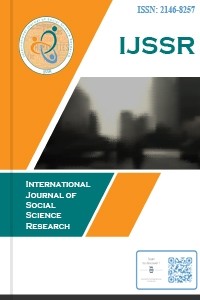Makro Ekonomik Faktörlerin Cari Açık Üzerine Etkisi: Türkiye İçin Zaman Serisi Analizi
Bu çalışmanın amacı, Türkiye’de seçili makroekonomik faktörlerin cari açık üzerindeki etkisinin 2003 : Q4 – 2018 : Q2 dönemi için incelenmesidir. Çalışmada, cari açık, reel GSYH, reel efektif döviz kuru, ham petrol fiyatları ve TCMB faiz oranına (O/N) ait veriler kullanılmıştır. Değişkenlere ait veriler TCMB Elektronik Veri Dağıtım Sisteminden (EVDS)’den ve US Energy Information Administration (E.I.A.) den elde edilmiştir. Değişkenler arasındaki eşbütünleşme ilişkinin tespit edilebilmesi için ARDL analiz yöntemi kullanılmıştır. Elde edilen bulgulara göre, makroekonomik değişkenlerden GSYH ile cari açık arasında uzun dönemde ekonomik ve istatiksel olarak anlamlı bir ilişki olduğu görülmektedir. Yani incelenen dönemde, beklenildiği gibi, Türkiye’de ekonomik büyüme ile birlikte cari açığın da arttığı anlaşılmıştır. Diğer taraftan, Türkiye Cumhuriyet Merkez Bankasının kısa vadeli (O/N) faiz oranı ve ham petrol fiyatları ile cari açık arasında sadece kısa dönemde anlamlı bir ilişki olduğu görülmüştür.
Anahtar Kelimeler:
Cari açık, ekonomik büyüme, petrol fiyatları, faiz oranları, Türkiye
___
- Akel, V. ve Gazel, S. (2014). Döviz Kurları ile BIST Sanayi Endeksi Arasındaki Eş Bütünleşme İlişkisi: Bir ARDL Sınır Testi Yaklaşımı. Erciyes Üniversitesi İktisadi ve İdari Bilimler Fakültesi Dergisi, 44: 23-41. Bozkurt, H.Y. (2013). Zaman Serileri Analizi, Genişletilmiş 2. Baskı, Bursa: Ekin Yayınevi. Dickey, D.A. & Fuller, W.A. (1981). Likelihood Ratio Statistics for Autoregressive Time Series with a Unit Root. Econometrica Journal of the Econometric Society, 49 (4): 1057-1072. Edwards, S. (2001). Does the current account matter?, NBER Working Paper no:8275. Engle, R. F. & Granger, W.J. (1987). Cointegration and Error Correction: Representation, Estimation and Testing. Econometrica, 55: 251–76. Eroğlu, İ., Yeter, F. ve Çidem, Y. (2018). Turkey's Current Account Deficit Problem of Perspective Energy Deficit And Recommendations for The Future, Balkan Journal of Social Sciences, 7 (13):106-118. Fisunoğlu, M. & Oransay, G. (2014), Current Account Deficit Sustainability in the Asset Demand Approach, International Conference on Eurasian Economies, 1-3 July, Skopje-Macedonia. Granger, C.W.J. & Newbold, P. (1974). Spurious Regressions in Econometrics. Journal of Econometrics, 2 (2):111-120. Gujarati, D.N. (1999). Temel Ekonometri, (Çev. Ü. Şenesen ve G.G.Şenesen). İstanbul, Literatür Yayınları Hakkio, C. S. & Rush, M. (1991). Is the budget deficit too large? Economic Inquiry, 29 (3): 429-445. Husted, S. (1992). The emerging US current account deficit in the 1980's: a cointegration analysis, The Review of Economics and Statistics, 74 (1): 159-166. Johansen, S. (1988). Statistical Analysis of Cointegration Vectors. Journal of Economics Dynamic and Control, 12 (2-3): 231–254. Liu, P. C. & Tanner, E. (1996). International intertemporal solvency in industrialized countries: evidence and implications, Southern Economic Journal, 62 (3): 739-749. Narayan S. & Narayan P.K. (2004). Determinants of Demand of Fiji’s Exports: An empirical Investigation. The Developing Economics, 17 (1): 95-112. Pesaran M.H., Shin, Y. & Smith, R.J. (2001). Bounds Testing Approaches to The Analysis of Level Relationships. Journal of Applied Econometrics, 16 (3): 289–326. Pitchford, J.D. (1990). Australia’s Foreign Debt: Myths and Realities. Allen and Unwin, Sydney.
- Yayın Aralığı: Yılda 2 Sayı
- Başlangıç: 2012
- Yayıncı: Şahin ORUÇ
Sayıdaki Diğer Makaleler
Metin AKTAŞ, Zabiullah DARWISH
Turgay ÖNTAŞ, Okan ÇOBAN, Taner ATMACA
Fen Bilgisi Öğretmen Adaylarının Sorgulama Becerilerinin Bazı Değişkenler Açısından İncelenmesi
Serdar KUZU, İsmail Erkan ÇELİK
Makro Ekonomik Faktörlerin Cari Açık Üzerine Etkisi: Türkiye İçin Zaman Serisi Analizi
